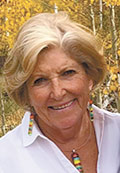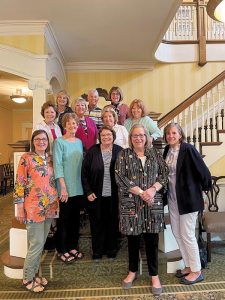July 1, 2021
Bunco: Not Just a Game of Dice
 By Mary Schricker Gemberling
By Mary Schricker Gemberling
“What happens at Bunco stays at Bunco!”
Shortly after I moved to the Quad Cities in the 1970s, I became friends with Carolyn Day and Linda Souhrada; as the years grew so did our friendship. When our children were young our families spent many a summer afternoon at the Day’s pool. Over time the demands of our family, our careers and life in general left less and less time to spend together. So one very rainy fall weekend in the late 1990s we decided to spend the day following the Spoon River Drive. We meandered from town to town stopping at just about every shop to buy unneeded chotskies and indulge in delicious home-made food. The harder it rained, the more we laughed, and by the end of the day the bonds of our friendship was as strong as ever.
On the last leg of our journey back to Davenport, we decided we could not stray again and needed a regular time to get together. Carolyn was playing in a neighborhood bunco group and suggested that maybe we could start our own and meet once a month.
So for those of you who have never heard of Bunco, I will digress from my story to give you a definition and short history of the game. It actually originated in 19th-century England where it was known as “eight dice cloth.” It was unknown in the United States until 1855, when it was introduced into San Francisco during the Gold Rush by a crooked gambler. This shady character had many stops in route to the California gold fields and after many changes to the game re-christened it Bunco or Bunko. During this same
period a spanish card game, Banco, and its Mexican derivative, Monte, were also introduced to the population of San Francisco. Bunco dice and cards were combined to form a more efficient method of conning hardworking people out of their money at gambling locations known as Bunco parlors. Hence, the word bunco came to be a general term that applied to all scams, swindling and con games.
Bunco flourished as the population grew and the economy recovered after the Civil War and into the turn of the century. Between 1879 and 1880 in virtually every city in the country Bunco-Banko games were in operation. Some gaming locations were lavishly furnished while others resembled professional offices. During the 1880s and into the mid 1890s, Bunco spread across the country. Through the Victorian era to WWI Bunco became a traditional family or parlor game to promote social interaction. During this time Bunco groups, consisting of 8-20 people enjoyed an evening of food, drinks, conversation and friendly competition.
During Prohibition and the roaring 20’s, the infamous Bunco dice parlors resurfaced in various regions of the US. The most notorious speak-easies and Bunco dice parlors were located around Chicago, Illinois. The term “Bunco Squad” referred to the detectives who raided these establishments. After Prohibition, Bunco groups declined in the major cities of the country, but spread to the suburbs. Not much was heard about Bunco from 1940-1980. Since the early 1980s, with a return to traditional family values and a sense of neighborhood and community, Bunco activity increased.
Today most Bunco groups consist of 12 players, usually women. How is Bunco is played? Here is a brief summary of how our group plays. Each game consists of six rounds, progressing in order from one to six. For the first round, players
divide in groups of four at various tables (we play with a group of 12 at 3 tables). Table one is designated as the head table and controls the beginning and end of each round.
 When play starts a signal (we ring a bell) is given and players at all tables begin rolling three dice trying to score points according to the rules of play. When a player at the head table scores 21 points the signal is given to end that round. After each round has ended players stand up and the winning team from each table moves up while the losing team stays put. After everyone has moved the next round begins. When all six rounds have been played the game is over. Two to three games can be played as time allows; prizes are given for most buncos, highest number of wins and highest number of losses during game time.
When play starts a signal (we ring a bell) is given and players at all tables begin rolling three dice trying to score points according to the rules of play. When a player at the head table scores 21 points the signal is given to end that round. After each round has ended players stand up and the winning team from each table moves up while the losing team stays put. After everyone has moved the next round begins. When all six rounds have been played the game is over. Two to three games can be played as time allows; prizes are given for most buncos, highest number of wins and highest number of losses during game time.
Before, during, and after the playing of bunco we indulge in food, drink, and much conversation and laughter. Anyone who has been in a room with twelve raucous women knows how loud it can get! But oh my we do have fun. Bunco for us is so much more than a game of dice.
We began sometime in the late 1990s (not one of us can remember the exact year) with twelve ladies. The ladies have evolved with only seven of the original members in the club today. Words cannot describe what we have shared in all the these years together. We have traveled together to Chicago & St. Louis and as far away as South Carolina, Florida, and Texas. In the summer we forgo bunco to enjoy swimming parties at the home of several members with pools. We have reveled in the successes of our children and the joys of grandchildren. We have supported each other in the loss of our parents and helped others grieve the loss of spouses. A few members moved away, and others joined adding renewed vitality to our group. We have supported each other through the hiccups of life and seen each other at our best and at our worst. We have laughed, listened, cried, hugged, and laughed some more. Our love is genuine! Thank you Carolyn Day for your wonderful idea so many years ago. None of us could have foreseen the trove of memories, the wonderful adventures, and the ever so valuable friendships that awaited us.
“The best prize I ever won at Bunco was your friendship!”
Mary, a former educator and Real Estate Specialist, is the author of four books: The West End Kid, Labor of Love, Hotel Blackhawk; a Century of Elegance, and Ebenezer United Methodist Church: 150 Years of Resiliency.


